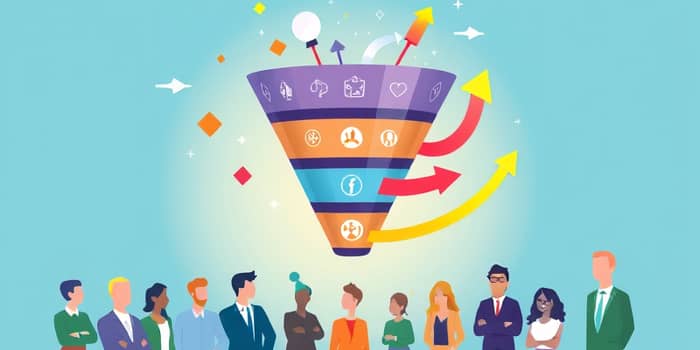Every business strives to turn curious strangers into enthusiastic, repeat buyers. A well-crafted sales funnel is the engine that drives this transformation. By visualizing each step a prospect takes, you can architect a structured path to conversion that nurtures trust, delivers value, and ultimately creates loyal customer advocacy.
In this comprehensive guide, we’ll explore proven strategies, benchmark data, and expert insights to design a high-converting sales funnel. You’ll gain actionable tactics to attract qualified leads, guide them seamlessly through each stage, and foster a community of brand champions.
Understanding the Sales Funnel
The sales funnel is a strategic map of the buyer’s journey, illustrating how prospects move from first awareness to brand loyalty. The funnel shape reflects that many may enter at the top, but only a select few reach the bottom. This visualization helps marketers optimize interactions and content at each stage.
Typically, funnels are divided into Awareness, Interest, Consideration, Intent, Purchase, and Loyalty stages. Some frameworks simplify these into TOFU (Top of Funnel), MOFU (Middle of Funnel), and BOFU (Bottom of Funnel). Regardless of terminology, the goal remains the same: convert leads into lifelong customers.
Setting Clear, Measurable Goals
Before building your funnel, define what success looks like. Goals provide direction and benchmarks for optimization. They should be specific, time-bound, and aligned with overall business objectives.
- Increase quarterly revenue by 20% through upsells
- Capture 1,500 new leads via gated content by Q3
- Boost demo-to-purchase conversion rate to 25%
By establishing measurable milestones, you empower your team to test strategies and refine tactics based on real data.
Mapping the Customer Journey
Mapping the journey involves defining the criteria that move a prospect from one stage to the next. Behavioral signals—such as content downloads, webinar attendance, or trial sign-ups—serve as triggers to advance them through the funnel.
Filling the Funnel with Qualified Leads
Attracting prospects requires a mix of channels and tactics. Focus on high-impact methods that resonate with your target audience and encourage them to exchange contact information for value.
- Content marketing: blog posts, whitepapers, and infographics
- Paid advertising: search ads, social media promotions
- SEO: optimize for keywords relevant to buyer intent
- Referrals and partnerships: leverage networks for warm introductions
Use lead magnets—such as webinars, checklists, or free trials—to capture interest. Each touchpoint should offer valuable, actionable content that aligns with the prospect’s current needs.
Nurturing and Educating Leads
Once prospects are in your funnel, it’s crucial to nurture them with tailored content. Segment your list based on behaviors, interests, and demographic data to deliver relevant messages at the right time.
Effective nurturing strategies include automated email sequences, retargeting ads, and personalized follow-ups. Share case studies that illustrate real-world applications, host live Q&A sessions, and provide clear comparisons between your solution and competitors. This personalized approach moves prospects from mere curiosity to genuine consideration.
Optimizing Conversion Points
The bottom of the funnel (BOFU) focuses on sealing the deal. Here, clarity and frictionless processes are key. Optimize your purchase paths by streamlining forms, offering transparent pricing, and providing strong guarantees.
Address common objections proactively. Highlight customer testimonials, outline support options, and simplify checkout steps. Remember, user experience at every stage can make or break a sale—fast-loading pages and clear calls to action are non-negotiable.
Cultivating Loyalty and Advocacy
A sale should never be the end of your relationship with a customer. Post-purchase engagement—through onboarding, training, and regular check-ins—reinforces trust and satisfaction.
Encourage repeat business by offering loyalty rewards, exclusive deals, and referral incentives. A satisfied customer who becomes a vocal advocate can drive significant new business through word of mouth. Aim to transform each buyer into a champion who shares positive experiences with peers.
Avoiding Common Pitfalls and Advanced Tips
Successful funnels aren’t linear. Some prospects skip stages, while others take unexpected detours. Monitor analytics closely and remain flexible in your approach. Regular A/B testing of emails, landing pages, and offers will reveal what truly resonates with your audience.
Segmenting your audience by behavior and persona allows you to deliver precision-targeted campaigns. Experiment with new channels, optimize underperforming areas, and always refine your strategy based on real-world feedback. This commitment to continuous measurement and iteration sets high-performing funnels apart.
Conclusion
Designing a high-converting sales funnel is both an art and a science. By setting clear goals, mapping the buyer journey, and delivering tailored experiences at each stage, you can turn casual visitors into loyal customers. Embrace data-driven optimization, nurture trust through valuable content, and cultivate advocates who fuel sustainable growth.
With this blueprint in hand, you’re equipped to build a funnel that not only generates revenue but also strengthens relationships and fosters long-term loyalty.
References
- https://www.salesloft.com/resources/blog/sales-funnel-definition
- https://www.cognism.com/blog/sales-funnel
- https://keap.com/product/sales-funnel
- https://www.zoho.com/crm/sales-funnel.html
- https://www.brevo.com/blog/what-is-a-sales-funnel/
- https://electroiq.com/stats/sales-funnel-statistics/
- https://www.pointspeakmarketing.com/digital-marketing/a-detailed-guide-to-building-the-perfect-sales-funnel
- https://www.salesforce.com/blog/what-is-a-sales-funnel/










